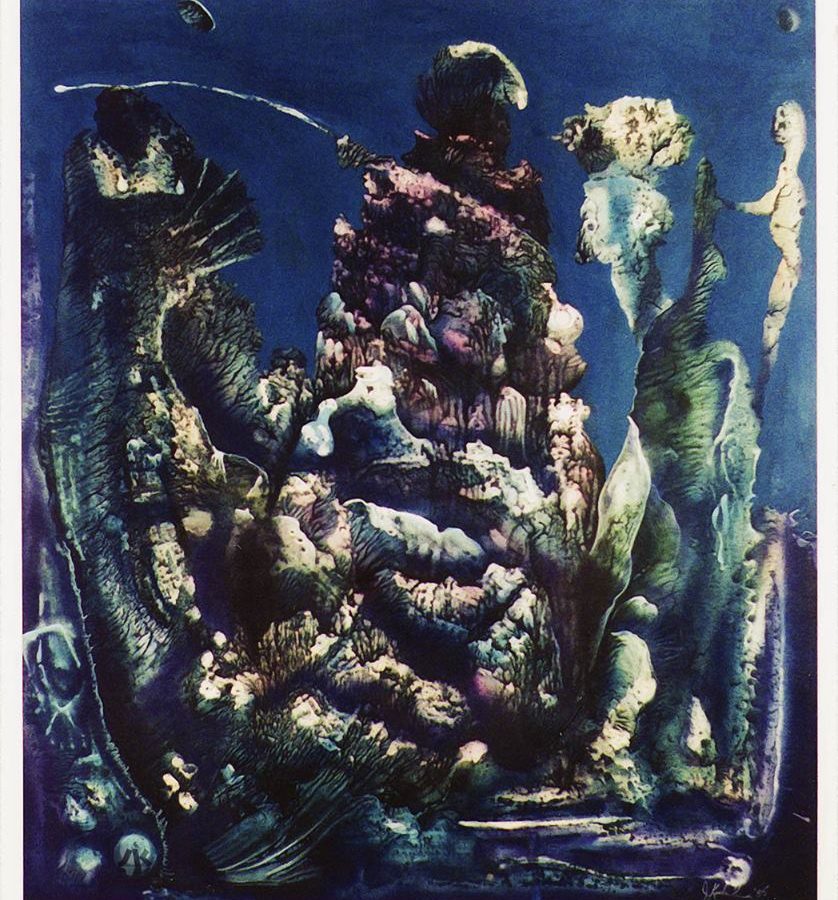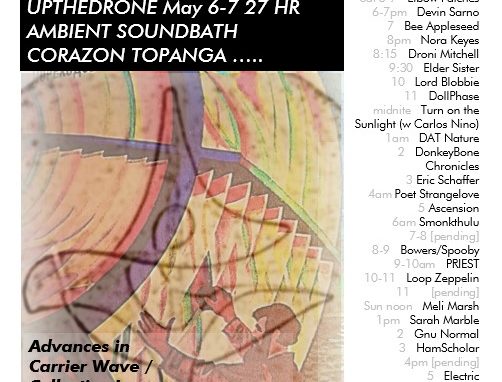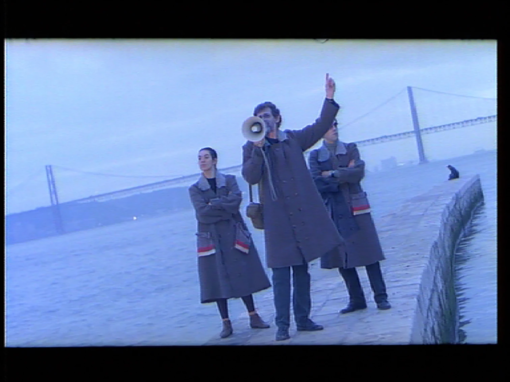Inspektor Boshe pondered the upside down horizon of Vermilion Sands through his whisky. Swirling ice cubes in his shot glass, the landscape jiggled and jumbled. Boshe was cool in the shade of the bar veranda but the dried lake bed out beyond was baking already, its filigree of infinite fractal fractures bending, blending and waving like one of Max Ernst’s decalcomanias, brought to life. The ice cubes distorted the distant stacks of lava cones and coral reefs.
What was he doing here, anyway? His investigation was adrift, no sign of progress. What few clues he had been able to scrounge up seemed to lead in circles, pointing everywhere and nowhere. Everyone here was potentially a party to the crime. They all seemed to know something. But none of the somethings added up. There appeared to be no actual, direct witness to the crime itself. Which made no sense, considering the scale of the Object, its visibility, its renown. And the Object’s creator was missing.
Back in his hotel room, Boshe’s pinboard of photos and notes and connecting string was starting to resemble the abstract art he so detested.
The days and weeks were beginning to blur together. He lit another cigarette. It was late morning, the bar was still empty. The headlines were boring, more political insanity, back in the Sprawl.
He had been sent to penetrate the social scene of Vermilion Sands. To track down an arsonist. An Art Arsonist, to be precise. Perpetrator of the greatest art crime that had ever been committed in this legendary string of decadent resort towns draped along the rim of a hallucinogenic bygone sea. Someone had incinerated the largest sculptural work ever created in the region.
“The Object.” A vast self-evolving totemic installation, just past the last hangar of Lagoon West. Once, The Object had dominated the horizon northwards. It had been written up, even in non-art zines.
Now, it was nothing but black ribs jutting into the sky.
Vermilion Sands, where everyone claimed to be an avant-garde artist of some kind, even if they did nothing but sit in the bars and go for occasional jaunts on the sand-yachts with celebrities and millionaires.
Maybe some of them actually funded some art, somewhere. Mostly they just talked about it. How could they afford to spend so much time here? Time spent doing much of nothing, at least as far as Boshe could tell. True, occasionally one would stumble into a truly obsessive artist-type, haunted by their unrealizable vision, usually strung out on a banquet of synthetic substances, or procrastinating completion of their masterpiece addicted to some VR-verse soap opera.
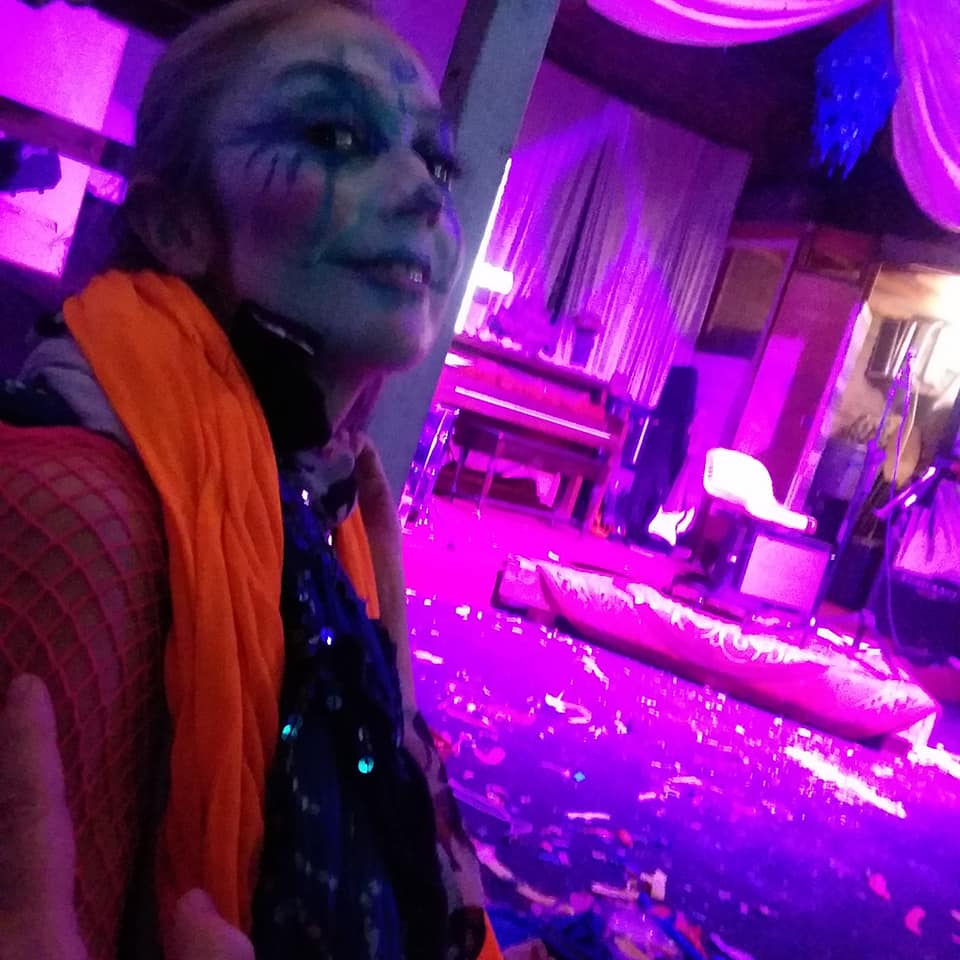
Perhaps, Boshe pondered, he just wasn’t gifted with the abstruse lingo needed to appreciate the gallery receptions, coffee house debates, avant-art trinket shops, winding back-alleys, unkempt villas, and ever-morphing desert-scapes of Vermilion Sands. Insufferably pretentious, it was the last kind of crowd Boshe would hang out with, left to his own devices. Perhaps this was a punishment by his home office for some misdeed – a sort of exile or psychic torture.
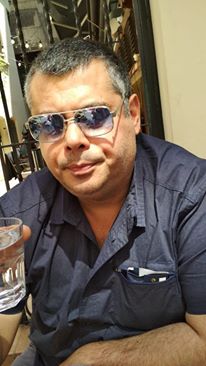
On the other hand, Bos reluctantly admitted to himself, the women were spectacular here. Exotic and alluring, in the extreme. For example, the one that had just sat down at the other end of the bar. Amanda “Des-Astres” Kline, he recognized her from some of the parties up at Van Stratten’s warehouse, parties Van Stratten promoted as orgies when in fact they were never more than staid art theory salons. They’d said hello a few times. Even by the outre style standards at Vermilion Sands, Kline stood out. Skin art was common, always evolving. But Kline had adopted the very latest in cutaneous reprogramming. Her left side was covered by a thin film of tan needles – like a thornrose. Her right side, shimmering turquoise scales. Arched eyebrows, and impossibly large Persian eyes, highlighted by a complex tattoo of calligraphy that coiled towards her ears.
“’Good morning, Inspektor. I need volunteers for my new performance piece. We are going to take 1000 people out to the Reef of Dreams and enact the Syntropic Equations, … with human bodies. Can I interest you in participating?”
“Syntropic Equations?”
“Yes, the Syntropic Equations.”
“My theory – excuse me, bartender, a Caipirinha please, thanks — is that with the Syntropic Equations, Luigi Fantippie actually channeled a form of post-modern magic, disguised as physics. But – I am tempted to lecture – it is part of my appeal to volunteers – do you mind if I give a bit more background? It gets a bit … technical & philosophic.”
“Ah, what else would I be doing this morning? I don’t claim to understand art, but go on, enlighten me.”
“As I was saying. Fantippie, Luigi Fantippie. A highly overlooked physicist – a contemporary and good friend of Fermi’s. His maths… are not simply de-scriptive… and not just pre-scriptive either… They are something the very opposite of explosive, they are transformigratory, supra-cohering. Think of Einstein’s E=MC2 and the atomic bomb. Fantippie’s Syntropic Equations — similar scale, … but of a qualitatively different nature. On the written page they do nothing. But they are waiting to be brought to life by the human form. But it’s never been done. You see, the human form is the ultimate embodiment of Syntropy.”
Boshe, bemused, puzzled over Kline’s art pitch. He’d heard all kinds of inscrutable aesthetic speculations while eavesdropping at parties, but nothing quite that early in the day, and nothing directed at him in particular.
This was the first time anyone in Vermilion Sands had invited him to be PART of an artwork. So far they had considered him an uncouth interloper, out of synch with the scene. His drab attire was only one more reason why no one took him seriously. Perhaps that’s why his leads led nowhere, or in circles. Perhaps, just perhaps, if he signed onto one of their mad art projects, he would acquire enough cool to make headway in his investigation.
“Sorry it’s a little early for me. I’m still on my first whisky. What was that word you used, ‘Syntropy?'”
“Yes, Syntropy. Despite your shabby, reductive, heart-less dualistic outlook, you too, Mr. Boshe, are an expression of Syntropy. Syntropy is all that is unexpected, novel, driven by the creative needs of the future, not the static, so-called “facts” of the past. You would like to believe you are only a man of the past. A creature of Entropy, another unwilling side-effect of the Second Law of Thermodynamics, obligated to maintain your metabolic and cognitive coherence only insofar as you expel greater volumes of waste and chaos into the world around you, in your wake, as it were. A travelling disaster with the illusion of self. But no, even you, my dear Inspektor Boshe, are a product of Syntropy.”
“I am?”
“Most certainly. But who can say what future need has drawn you here? For the moment, I could certainly put you to use in my performance, if you had the courage to be part of such an experiment with potentially unexpected… perhaps even singular… results…?”
Kline had shifted a few seats closer. She unfolded a display. It showed the math. A photo of Fantippie from the 40s. And a long quotation from the physicist.
Boshe shrugged, unimpressed. “Sorry, I don’t know much about physics. Entropy or … syntropy… it’s all the same to me. Fancy word games. I just deal with the here and now. Things I can … touch and feel.”
The idea of fondling Kline’s thorns induced a quiver of revulsion in Boshe. And attraction? Still he was attracted, even if he couldn’t stand the fancy language. And the creepy thorny skin. Kline’s thorny side ruffled, and her arched eyebrow arched further, her eyes narrowed. “Very well. No need to believe in the ideas of my project to simply participate. I just need your body.”
“Excuse me?” Boshe coughed. “I just need your body. For a day. For the performance piece.”
Boshe shrugged again. He should try to play it cool. Maybe this was his in. “Just for a day, then?”
“Yes, for the day. It will take some time to get out to the Reef. There will be some set-up. The performance itself will take time. We may not get back to town til … very late.”
“OK, I see. Sounds doable. But, … what will we be doing, exactly? What are you expecting of me? I have no experience in performance art.”
“You will be arranged with all the others. As puzzle pieces, as units. Your bodies, linked together, will spell out the equation on the floor, just at the foot of the Reef. I will be directing you, telling you where to go. Others will record the event.”
Having no experience in such matters, Boshe merely nodded. “Sounds good, I guess.”
Kline added, “Oh. And there is a waiver, of course.”
“A waiver?”
“Just a formality. I mean, there is a slight risk of… insanity… from this performance piece. It will be a first. I mean, that’s the whole point, isn’t it?! It’s an experiment, we are probing into the Singularity itself. No pain, no gain.”
Boshe was unclear whether she was, at this point, joking or not. “I’m not sure what you’re saying. There’s a risk of losing my mind, … if I do this performance with you?”
“We are playing with the parameters of time and awareness, after all. It wouldn’t be art if we weren’t no?”
“Well uh…” Boshe didn’t really know where to take that. He looked over the waiver language on the display. Legalese, impenetrable. “I guess some people do get a little crazy when they stay out on the lakebed too long.”
“True, that is part of the allure of the Reefs and the Mountains, isn’t it? Changes in perception…”
“OK I’ll sign it. Can’t see how just standing around in an art performance could make me lose my mind. How many other people have signed off so far?”
“All 999. You’re the last one I need,” responded Kline.
“Very well, I’ll help you complete your show.” Boshe put his fingerprint on the display, signing off on the waiver.
“When does it happen?”
Kline responded, “This coming Sunday. Be ready at dawn at the edge of town, we’ll have some sand yachts ready to take you all out to the Reef.”
Despite himself, Boshe was bemused. Perhaps he was finally getting somewhere in his investigation. He had yet to build up any trust with the locals. Probably they were hiding something. Now he would be like one of them, a willing subject of an art project, … in which he might stand a chance of losing his mind. By merely spelling out a physics equation, his own body one of many letters in a giant code.Later that night, back in his hotel, Bos pulled up Fantippie. As best as he could tell, Fantippie was a real person. But his great “Syntropic Equation” seemed to have zero weight in the global physics and academic community. Most of what he could find was in Italian. He found a long quote,
I have no doubts about the date when I discovered the law of syntropy. It was in the days just before Christmas 1941, when, as a consequence of conversations with two colleagues, a physicist and a biologist, I was suddenly projected in a new panorama, which radically changed the vision of science and of the Universe which I had inherited from my teachers, and which I had always considered the strong and certain ground on which to base my scientific investigations. Suddenly I saw the possibility of interpreting a wide range of solutions (the anticipated potentials) of the wave equation which can be considered the fundamental law of the Universe. These solutions had been always rejected as “impossible”, but suddenly they appeared “possible”, and they explained a new category of phenomena which I later named “syntropic”, totally different from the entropic ones, of the mechanical, physical and chemical laws, which obey only the principle of classical causation and the law of entropy. Syntropic phenomena, which are instead represented by those strange solutions of the “anticipated potentials”, should obey two opposite principles of finality (moved by a final cause placed in the future, and not by a cause which is placed in the past): differentiation and non-causable in a laboratory. This last characteristic explained why this type of phenomena had never been reproduced in a laboratory, and its finalistic properties justified the refusal among scientists, who accepted without any doubt the assumption that finalism is a “metaphysical” principle, outside Science and Nature. This assumption obstructed the way to a calm investigation of the real existence of this second type of phenomena; an investigation which I accepted to carry out, even though I felt as if I were falling in a abyss, with incredible consequences and conclusions. It suddenly seemed as if the sky were falling apart, or at least the certainties on which mechanical science had based its assumptions. It appeared to me clear that these “syntropic”, finalistic phenomena which lead to differentiation and could not be reproduced in a laboratory, were real, and existed in nature, as I could recognize them in the living systems. The properties of this new law, opened consequences which were just incredible and which could deeply change the biological, medical, psychological, and social sciences.
…to be continued…?
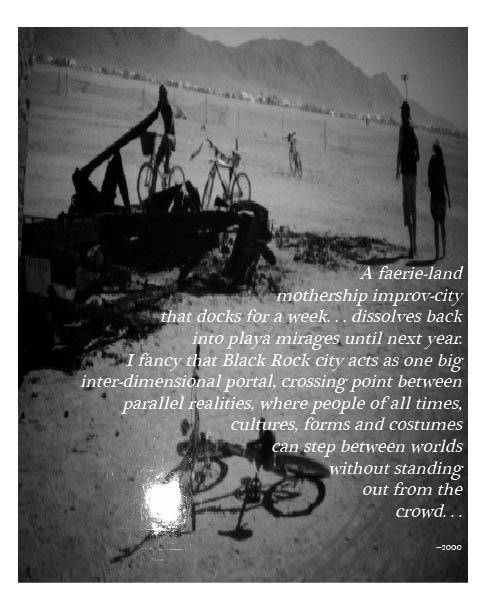
Copyrite 2019, Cynnamon Twyste
lead image by James Koehnline;
thanks to Komrades AAA & AA for misuse of their mugshots;
closing image courtesy Cynnamon Twyste

